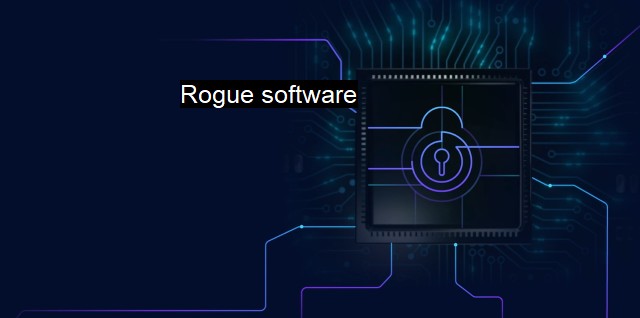What is Rogue software?
The Threat of Rogue Software: How Malicious Programs Pose a Danger to Your Computer and Identity
Rogue software, often referred to as scareware, is at its base malicious software packaged to feign fundamental functions. Typically packaged as antivirus software, it promises the user protection against cyber threats while subtly, and sometimes overtly, infecting users' devices with malware or collecting private data for sinister ends. This software aims to convince users that their systems are at risk to rouse fear. This fear is then exploited, compelling users to pay for a "full" version to remove the advertised threats. Because these threats are fictitious, paying for the software is a pointless, dangerous, and costly affair. Often, it only stimulates further illicit activities.Within the cyberspace, the presence of rogue software presents a looming threat. As users become increasingly wary of preventing cyber attacks, hackers are evolving and becoming more technical in devising an array of deceptive tactics. In contrast to regular malware, which generally makes surreptitious entrances and spirals into your system, rogue software operates under a deceptive guise. It's an wolf in sheep's clothing.
It can be even more threatening because it exploits the very shield users set up for protection – their antivirus software. Being inconsistently updated and often used without much technical understanding than danger mitigation by most users, antivirus softwares are fertile grounds for the settlement and functioning of these rogues.
The execution usually follows an alarmingly simply blueprint, which is its alarming success aspect. Users install a software, which then runs a scan that results in the detection of an excess of threats. Nervous users are then prompted to make a purchase to vanquish these fabricated threats. Complemented with false graphical interfaces, promotional messages, and credibility enhancing antics like 'crisis discounts', the authenticity illusion stays intact in the bargain.
Installation is a crucial element. It demands persuasion for user consent and employs ingenious ways to achieve it. It ranges from creating a buzzing demand with the prettification of functionalities to more obscurity like certain websites secretly installing it upon visitation. More sophisticated approaches include bundling these with other mainstream software operation paths. This feature intelligently merges with general update prompts and behavior suggesting that anything less than installation leaves gaping vulnerabilities. This strategy ensures its continual maintenance and access to manipulative updates and payloads.
Recognizing rogue security software isn't an insurmountable task. One remarkably tangible pointer is constant bombardment with alarming pop-ups of unverifiable threats and immediate actions. Impediments owing to blocked access to certain features or websites until actions are taken, or noticing inexplicable disruptions in standard computer operations, may all be signs pointing towards scareware riffing through your system's underlines.
Regular subscription to high-level and peer-reviewed security software vendors instead of relying on sporadic, unknown source antidotes is crucial in prevention. maintaining heightened vigilance for consistent system updates, patches, and unfamiliar intrusion detection can be highly beneficial. Deploying intrusion detection systems with broad spectrum coverage can strike at the root, eradicating undetected sprawl before mass contamination.
Though frustrating, dealing with false positives might prove iffy at the worst. It can be easily sidelined with a mere check with peers to ensure validity. But purchasing rogue software, entwining within ugly and threatening tangles, can prove seriously severe, even catastrophic.
As cybersecurity gains more relevance, understanding threat dynamics, including well-cloaked tactics like rogue software, is imperative to maintain a comprehensive protective arsenal. These persistent threats underline the significance of practicing cognitive defense alongside technical coverage to ensure systematic security layers in the digitally linked world. Rogue programs are indeed an unwarranted provocation we need to counter with strategic measures enthusiastically.

Rogue software FAQs
What is rogue software?
Rogue software is any type of malicious program that is intentionally designed to harm a computer system or steal personal information without the user's knowledge or consent.Why is rogue software considered dangerous for cybersecurity?
Rogue software can compromise the entire security of a system by granting unauthorized access to sensitive data, allowing malicious attacks, and infecting other devices in the network.How can rogue software be prevented?
Rogue software can be prevented by using reputable antivirus software, regularly updating security patches and software updates, avoiding downloading software from unknown sources, and carefully reading and reviewing any pop-up warnings or unexpected requests.What should be done if a system is already infected with rogue software?
If a system is infected with rogue software, it is important to immediately disconnect the device from the internet and run a full system scan with a reputable antivirus program. It may also be necessary to seek professional assistance to fully remove the malware and repair any damage it has caused.| | A | | | B | | | C | | | D | | | E | | | F | | | G | | | H | | | I | | | J | | | K | | | L | | | M | |
| | N | | | O | | | P | | | Q | | | R | | | S | | | T | | | U | | | V | | | W | | | X | | | Y | | | Z | |
| | 1 | | | 2 | | | 3 | | | 4 | | | 7 | | | 8 | | |||||||